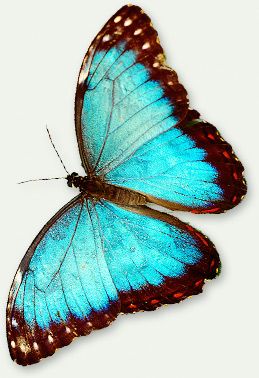The topic this week is nanotechnology and Art. There are several
parts of the lecture influenced my understanding of this topic. The Blue
Morpho Butterfly is the first thing piques my interest in this topic. The wings
of the butterfly are not colored on its surface. What really happens is a
manipulation of the photons which make our eye to see the color of blue. The nanotechnological approach is very
interesting in the sense that a phisically small and tiny change will cause
huge impact just like the color change. This method of “coloring” is also
responsible for the colors of beetle shells, mother-of-pearl, soap bubbles, and
the feathers of hummingbirds, blue jays, and pheasants.
A picutre of Blue Morpho Butterfly
http://www.webexhibits.org/causesofcolor/images/content/blueMorpho.jpg
Secondly, the Nano-scientists
create a barrier to maintain the air pressure and bounce of the inner core of
the tennis ball, Air D-Fense. This barrier extends the lifetime of each tennis
ball to a double. I thought that nanotechnology is a cutting-edge science which
may not be applicable in the real life of a normal human like me. However, this
example changes my mind because I am a tennis lover. I believe that this
barrier will reduce millions of people’s cost of buying new tennis ball. The
professional tennis players will definitely love this because they save more
money than a normal person. Nanotechnology is everywhere.
A thorough explanation of how the air barrier works
http://www.anntincheng.com/files/gimgs/14_picture-24.png
Lastly, the application of nanotechnology in the field of
medicine may be one of the most beneficial ones to human beings. One example of
nano-medicine is the use of nanotechnology for brain cancer. Nano-medical
materials, which are modified at the atomic or molecular level, may have the
potential to be game-changers for brain cancer patients. The blood-brain
barrier (BBB), a semi-permeable membrane of tightly knit capillary
endothelial cells that protects the brain from harmful substances in the blood,
and the tumor cell membrane itself. Nanotechnology can be used for saving
people’s life given that the death rate from brain cancer is one of the highest
among all the other kinds of cancers.
the effect of the use of nano-medicines for brain cancer
http://www.nature.com/nmat/journal/v12/n11/images_article/nmat3792-f3.jpg
All in all, the use of technology has created huge impact
into people’s life. Personally, I really appreciate the effort of the
nano-scientists to improve the quality of my life. It will be great if it can
be applied to save people’s lives just like the nano-medicines.
Reference:
"Butterflies | Causes of Color." Butterflies | Causes of Color. N.p., n.d. Web. 24 Nov. 2013. <http://www.webexhibits.org/causesofcolor/15A.html>.
"Nanotechnology To Double The Life Of Tennis Balls and Improve Tyres - New Product."Nanotechnology To Double The Life Of Tennis Balls and Improve Tyres - New Product. N.p., n.d. Web. 24 Nov. 2013. <http://www.azonano.com/article.aspx?ArticleID=319>.
NCBI. U.S. National Library of Medicine, n.d. Web. 24 Nov. 2013. <http://www.ncbi.nlm.nih.gov/pubmed/23738667>.
"About Dana Press." Treating Brain Cancer with Nanomedicine. N.p., n.d. Web. 24 Nov. 2013. <https://www.dana.org/news/features/detail_bw.aspx?id=35592>.
"15 Astonishing Real-Life Applications of Nanotechnology | Urbanist." WebUrbanist RSS. N.p., n.d. Web. 24 Nov. 2013. <http://weburbanist.com/2008/08/17/15-astonishing-real-life-applications-of-nanotechnology/>.




.jpg/200px-Die_Traumdeutung_(Congress_scan).jpg)



